This topic explains what plants are made of, how they survive, and how they reproduce. It is a relatively simple topic compared to the other additional higher levels, and it marks the end of molecular biology in the course (except the options). There are no immediate challenges, except that there are some fancy words, but that should not be too much of a problem. Otherwise, it was a fun chapter and I assume that there are many interesting experiments involved in the process.
Points for revision:
- Hormones involved in plant growth
- Fertilization, seed structure, and germination
Vascular plant anatomy
Plants can be divided into three parts, the root, the stem and the leaves. The root provides water and nutrients for the leaves so they can carry out photosynthesis, and the stem supports the leaves and brings them closer to the sun. Vascular plants have veins that go all the way from the root to the leaves and are comprised of xylem and phloem. Xylem transports water and phloem transports nutrients and other chemicals.The leaves of plants are important because they carry out photosynthesis in addition to creating a big surface area for evaporation in a process called transpiration. We will come back to why it is important later. The underside of leaves has openings called stomata guarded by guard cells. These openings let carbon dioxide flow in for photosynthesis and lets oxygen and water vapor flow out as waste products. The guard cells open and close as a result of water pressure, called turgor. When there is a lot of water in the plant, the guard cells swell and opens the stoma, and when there is little water, the guard cells shrink and closes the stoma. The stomata are on the same layer as the epidermis, which serves a similar function as our skin. Think of the epidermis and stomata as skin and pores. On the side of the leave facing up there can be a waxy layer called a cuticle. The cuticle reduces excessive transpiration and protects against insects. In between the surface and underside of the leaf is the mesophyll. It is divided into the palisade and spongy mesophyll. The palisade mesophyll is close to the surface of the leaf and therefore has a lot of chloroplasts to increase the rate of photosynthesis. The spongy mesophyll does not have as many chloroplasts because it is on the underside of the leaf. However, it serves as a medium for gas exchange.

The roots of plants are important because they provide the water and nutrients needed for photosynthesis. It can be divided into three zones, the zone of cell division, zone of elongation, and zone of maturation. The zone of cell division is close to the tip of the root, and here the plant cells undergo mitosis and replicates to make more cells. As time goes on, these cells mature and grow, and the area where the cells grow is called the zone of elongation. When the cells are fully grown, they become a part of the root that serves a function, in an area called the zone of maturation. Furthermore, roots have small projections called root hairs, root hairs greatly increase the surface area of the root. At the tip of the root there is a root cap that protects the root tip.
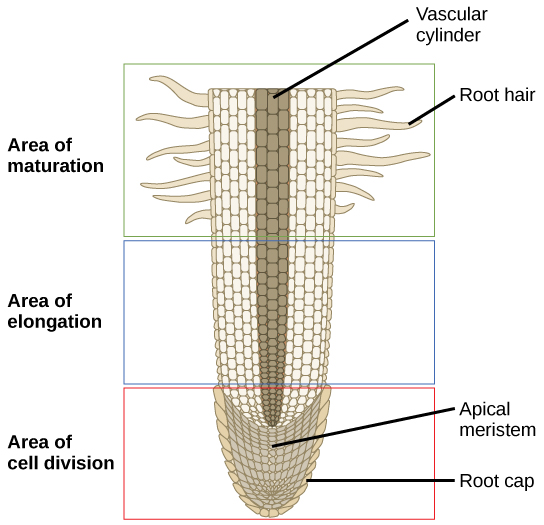
Xylem transport
The xylem is basically the water transport system of plants. It goes from the roots all the way to the top of the tree. In most modern plants the xylem is made of vessel elements, but some more ancient plants have xylems made of tracheid’s instead. A few plants have both vessel elements and tracheids. Both vessel elements and tracheids are made of tubes of dead cells.
Xylems manages to transport water against gravity due to the cohesion-tension theory. The cohesion-tension theory says that the xylem is filled with a water column, and when water transpires from the leaves, the hydrogen bonds between the water molecules adheres them together, almost like a chain of beads. The cohesion-tension theory can be visualized as a tube with beads. The tube represents the xylem, and the beads represents water. When the bead at the top is pulled, the other beads follow. Imagine that there is an unlimited pool of beads connected to the string at the bottom of the tube. This is the water reservoir at the roots. If there is no water left in the reservoir, the beads will eventually all be pulled out of the tube, and the plant dies. In addition to the cohesion-tension theory, water is pulled into the roots by osmosis. When water with dissolved minerals is pulled into the roots, the concentration of minerals in the roots becomes higher than in the ground. This causes water to diffuse into the roots by diffusion, further increasing water uptake.
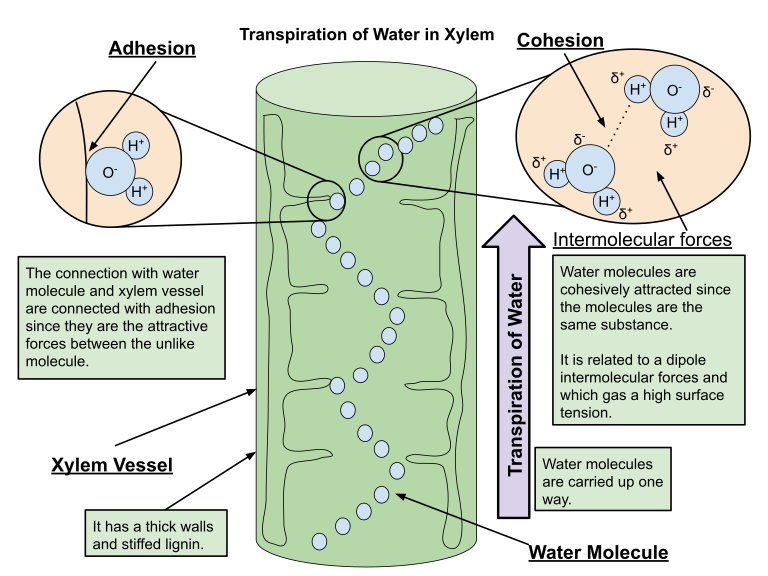
Phloem transport
The phloem is like our blood vessels, it transports material around the plant. Material in the phloem flows from a source to a drain. A source is where the material is made, usually the leaves since they are sites for photosynthesis, and a drain is where the material is used or stored. Phloem is made of sieve tube members and companion cells. In contrast to the cells in the xylem, the cells in the phloem are alive. This is because they need to carry out active transport. Transport in the phloem is carried out by the pressure flow hypothesis. According to the pressure flow hypothesis, the material that needs to be transported is loaded from the source to the phloem by active transport. As the concentration in the phloem increases, water diffuses into the phloem by osmosis. Since water is incompressible, the pressure increases. The pressure wants to move to a low pressure and therefore flows to the drain in bulk flow. At the drain the material is actively transported out of the phloem and into the drains, which reduces the concentration in the phloem, thus causing water to diffuse back into the xylem.
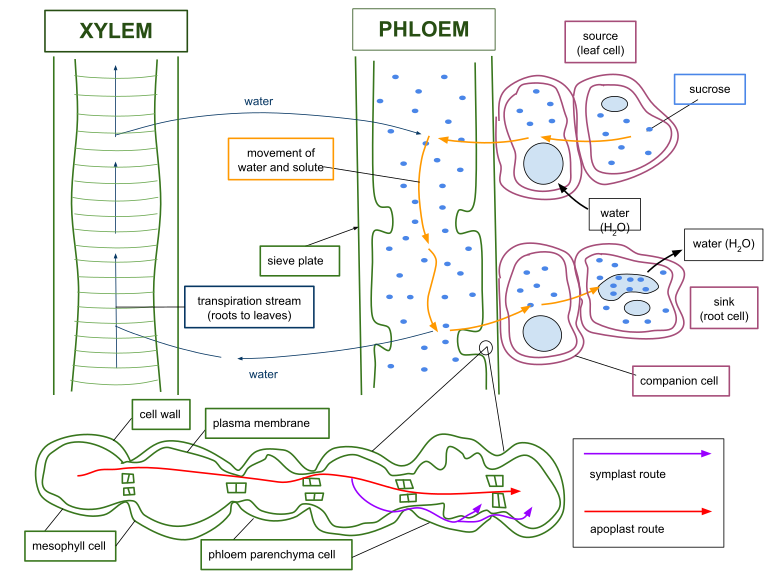
Plant growth
Plants have three main types of tissue, dermal tissue, vascular tissue, and ground tissue. Dermal tissue in like our skin, it protects the plant from the outside. Vascular tissue is what xylem and phloem is made of. It is the transport system of the plant in addition to providing support. And finally, ground tissue is basically everything that is not dermal or vascular tissue. It serves functions in photosynthesis, storage, support, and secretion. All plant tissues are derived from what is essentially the stem cells of plants, meristematic tissue. Meristematic cells can divide while still retaining its ability to further divide and differentiate. If the meristematic tissue can continuously divide, it is called indeterminate growth. If the meristematic tissue stops dividing at some point, it is called determinate growth.
Meristematic tissue (also called meristem) is divided into two types. Apical meristems and lateral meristems. Apical tissue is present in the areas where the plant will grow, providing new tissue such as in the shoots or roots. Apical meristems provide primary growth and is therefore sometimes called primary meristems. Lateral meristem however grows where the plan has already grown, such as the stem. Lateral meristem provides thickness to the plant. This is why it is called secondary growth. Lateral meristem is divided into two types, vascular cambium and cork cambium. Vascular cambium is responsible for most of the growth by growing secondary xylem and phloem, which becomes wood when the plant dies. Cork cambium is what grows the outer bark of the plant.
Hormones involved in plant growth
Plant growth is also influenced by environmental factors and hormones. Auxin is a type of hormone that makes the plant cells more flexible, thus elongating them and giving an effect of growth. Auxin is produced in most plant cells, but it is transported actively to the side of the plant opposite to the sunlight by auxin efflux pumps. A higher concentration of auxin in the side opposite of the sun causes more growth in that area, which makes the plant bend towards the light. This is called positive phototropism.
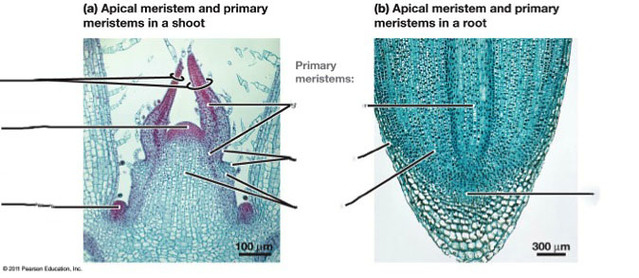
Plant reproduction
An angiosperm is any plant that has flowers, and angiosperms can be sorted into two groups, the monocots and the dicots. There are a lot of subtle differences between the two, but they both have in common that they have flowers as their reproductive organ. A few major parts of a flower are the male and female reproductive organs, the sepal, and the petals. The male reproductive organ is called a stamen and is comprised of an anther and a filament. The anther is the part that holds the pollen (sperm), and the filament supports the anther. The female reproductive part is called a carpel, and is comprised of a stigma, style, and ovary. The stigma is the opening of the carpel, and it contains a sticky fluid that can catch pollen. The style is a long neck that supports the stigma and leads to the ovary, which is where the egg resides. Sepals protects the flower when it is still in development, and the petals are used to attract pollinators. A flower that contains all the parts is called a complete flower, any flower that misses one of the parts is called an incomplete flower.
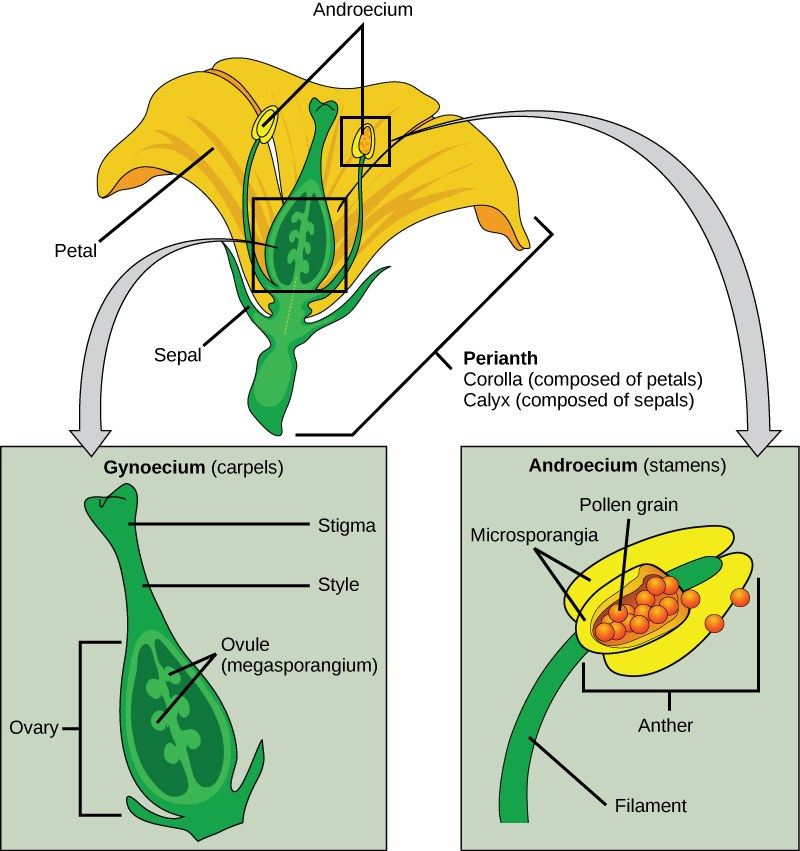
Pollination
Pollination is the process where pollen is attached to the stigma, and plants use various techniques to facilitate pollination. The most common pollen vector is other insects and animals such as bees, birds, and bats. Plants secrete products which are useful to these organisms, so that they go between flowers to collect the products, while simultaneously spreading pollen from flower to flower. A type of cooperation between two organisms that benefits both is called mutualistic symbiosis. Other ways to pollinate may be to take advantage of natural forces such as the wind. Self-pollination occurs when pollen from a flower falls into the stigma of the same plant. This increases the chance of pollination but reduces genetic variation. Cross pollination occurs when pollen is transferred from one plant to another plant. Cross pollination reduces the chance of pollination but increases variation.
Fertilization, seed structure, and germination
When the pollen meets the egg, they form a diploid seed which can grow to be a new plant. This process is called fertilization. As the fertilization goes on, the seed is enclosed in a fruit. This both protects the seed as well as providing it with a way of spreading. When an animal such as a fox eats the fruit, it will poop out the seed in another location, where the seed may grow into a new plant. A seed is protected by a tough layer called testa and inside the testa is the embryo root and embryo shoot, which will grow to become the new plant in a process called germination. Many environmental factors can determine when the plant will germinate, among other factors are water, temperature, and oxygen.
Helpful videos:
Xylem transport: https://www.youtube.com/watch?v=d60lqIfGeQw
Phloem transport: linkhttps://www.youtube.com/watch?v=hZAxvlXDiqA
Vascular plants: https://www.youtube.com/watch?v=h9oDTMXM7M8
Plant reproduction: https://www.youtube.com/watch?v=ExaQ8shhkw8
This was a much quicker topic than the previous higher levels, and it was so just so nice with a break from the difficult stuff. Overall, I enjoyed the process, but the content was not the best. However, it was still interesting because I did not know any of it before. Once again, Youtube videos are a great way to learn.